With this guide, we’ll tell you everything about WooCommerce Shipping and the various WooCommerce Shipping Plugins available. We’ll also explore the best ways to achieve your WooCommerce shipping conditions using practical examples.
WooCommerce Shipping Overview
WooCommerce offers an excellent environment for its users to set up and provide the desired shipping rates, methods, conditions, discounts, and much more. There are a lot of things that govern the shipping methods, without having to mandle the things in our own way. This could result in making the shipping discounts in the best way possible. So, no, there are no other types of WooCommerce shipping plugins available at the moment. Hence, in order to avoid this, shipping rates must be calculated in such a way that the customers can feel comfortable paying the extra amount. One of the best ways to do this is to make sure the shipping calculation is transparent. Doing so will help the customer avoid any unpleasant surprise while placing his/her order or from abandoning the cart.
Table of Contents
- WooCommerce Shipping Methods
- WooCommerce Shipping Settings
- WooCommerce Shipping Classes
- Create WooCommerce Shipping Classes
- Assign WooCommerce Shipping Classes to Products
- Example: Setting up WooCommerce Flat Rate Shipping method for a Simple product belonging to a Particular Class
- Example: Setting up WooCommerce Flat Rate Shipping method for a Variable product belonging to Parent product
- Common WooCommerce Shipping Requirements and Cases
- WooCommerce Free Shipping based on Count, Cost, Destination, and Shipping Class
- WooCommerce Flat Rate Shipping based on Quantity, Shipping Class, Destination and Cost
- WooCommerce Weight based Shipping
- WooCommerce Shipping by Cart Total and Quantity
- WooCommerce Shipping Rates for Product Category or Shipping Class
- WooCommmerce Shipping based on Per Product
- WooCommerce Local Pickup or In-store Pickup
- WooCommerce Shipping Rates from Carriers
- WooCommerce Table Rate Shipping
- WooCommerce Shipping Rate with Bundle/Combo Offer
- WooCommerce Shipping Automation
WooCommerce Shipping Methods
In WooCommerce terminology, the shipping options displayed on the cart page are termed as WooCommerce Shipping Methods. On a broader scale, we can classify WooCommerce shipping methods in the following categories:
- Basic WooCommerce Shipping Methods
- Advanced WooCommerce Shipping Methods
Standard WooCommerce Shipping Methods
By default, WooCommerce provides the following three basic shipping options to its users.
- Flat Rate
- Free Shipping
- Local Pickup
WooCommerce Free Shipping
WooCommerce Free Shipping, as the name suggests, would not charge or show any amount to the customers whenever an item is moved into the Cart. You can use the WooCommerce Free Shipping using a coupon, by defining a minimum order amount, or both. One of the most practical applications of free shipping is as a business strategy in order for customers to spend more. For instance, the store owner can offer free shipping on orders over a particular value. However, since Free Shipping is a write-off that store owners have to incur between their profitability and providing customers with a good experience, it has to be employed very prudently. As shown below, the WooCommerce Free Shipping method can be accessed by navigating WooCommerce > Settings > Shipping > Shipping Zones > Edit Zone > Add a Shipping Method.

WooCommerce Flat Rate
WooCommerce Flat rate is a rate that is fixed for an individual WooCommerce Shipping zone or more. A set of complicated mathematical calculations are normally used in order to arrive at this rate. For example, you can charge customers either based on charging 10% of the overall order cost or on the number of items in the cart for shipping. As shown below, the WooCommerce Flat Rate Shipping method can be accessed by navigating to WooCommerce > Settings > Shipping > Shipping Zones > Edit Zone > Add a Shipping Method.

Local Pickup in WooCommerce
The WooCommerce Local Pickup selection is used by customers when they prefer to pick up the order directly from the store/pick-up point. If the e-commerce business has this facility, a surcharge can be applied if needed. The WooCommerce Local Pickup Shipping method can be accessed by navigating to WooCommerce > Settings > Shipping > Shipping Zones > Edit Zone > Add a Shipping Method.

For WooCommerce users, there are many commercial and free shipping method extensions that are available to help you to perform some simple as well as complicated shipping calculations. These plugins can be downloaded from the WordPress plugin repository or from the commercial plugin developers. These plugins also help you to fix a shipping rate for your products based on various parameters including product weight, dimensions, shipping destination, order quantity, and more.
Advanced WooCommerce Shipping Methods
If you’re looking to add an advanced shipping method to add to your store, here are the best ways to do that. These shipping methods give the user more control and the ability to construct the desired shipping scenario. Please know that since these options aren’t offered by WooCommerce, you will have to choose the appropriate WooCommerce Shipping plugin.
WooCommerce Conditional Shipping
The WooCommerce Conditional Shipping means that you can manage and offer shipping rates based on various conditions. These conditions let you command the product’s journey to the Cart and thus, is considered the most flexible among all the WooCommerce shipping methods.
WooCommerce Table Rate Shipping
The WooCommerce Table Rate Shipping method lets you to create multiple WooCommerce Shipping Zones for various countries, states, and postcodes. You’re also able to create different rate tables for each zone. Users are also, provided with the option of calculating the rate on a per-order basis or based on the sum of the rates for the different items in the order. Rates can be fixed based on the following parameters:
- WooCommerce Shipping class
- Product Weight
- Product Dimensions
- Number of Items
- Cost
You can also fix a maximum and minimum value for the shipping rates in this method. Shipping rates can be given on the following basis:
- Per line
- Per item
- As a percentage of the item cost
- Based on weight
WooCommerce Flat Rate Box Shipping
The WooCommerce Flat Rate Box Shipping method allows you to have different WooCommerce Shipping zones set up for different countries, states, and zip codes. You can also create multiple tables with different shipping rules within the zones. Each zone will permit you to define the shipping boxes used for packaging and will include the length, breadth, and height along with weight restriction. The shipping rates can be configured based on a fixed rate, percentage, and rates based on weight of the order. Those items that are then ready to be shipped will be packed into boxes, based on the volume of the contents.
WooCommerce Per Product Shipping
This shipping method allows you to define shipping rates at product and variation levels. Rates can be defined as fixed or a percentage of costs based on the following parameters:
- Per line
- Per item
- Based on country codes or post/zip codes
The rates can be offered as a standalone shipping rate (in case of per-product shipping) or added to other shipping method rates. There is a list of products with a fixed shipping cost while the remaining it varies depending on the product.
WooCommerce Local Pickup Plus
In this shipping method, you can define locations where you will offer local pickup at optional costs. Many small businesses prefer this shipping method type since it’s convenient for the customers living near your store location or warehouse.
WooCommerce Carrier Shipping Carrier and Live Rates
This shipping method provides real-time or live shipping quotes. Here, rates are obtained from a third-party Application Programming Interface (API), for shipping carriers like USPS, DHL, UPS, Canada Post, Australia Post, and FedEx. Most of these carriers support box packing or provide rate quotes per product. They can be customized to show multiple rates or the cheapest rate.
WooCommerce Shipping Settings
To use shipping, you will have to enable it on the General tab of your store’s WooCommerce settings. You can find these settings by visiting WooCommerce > Settings > General.
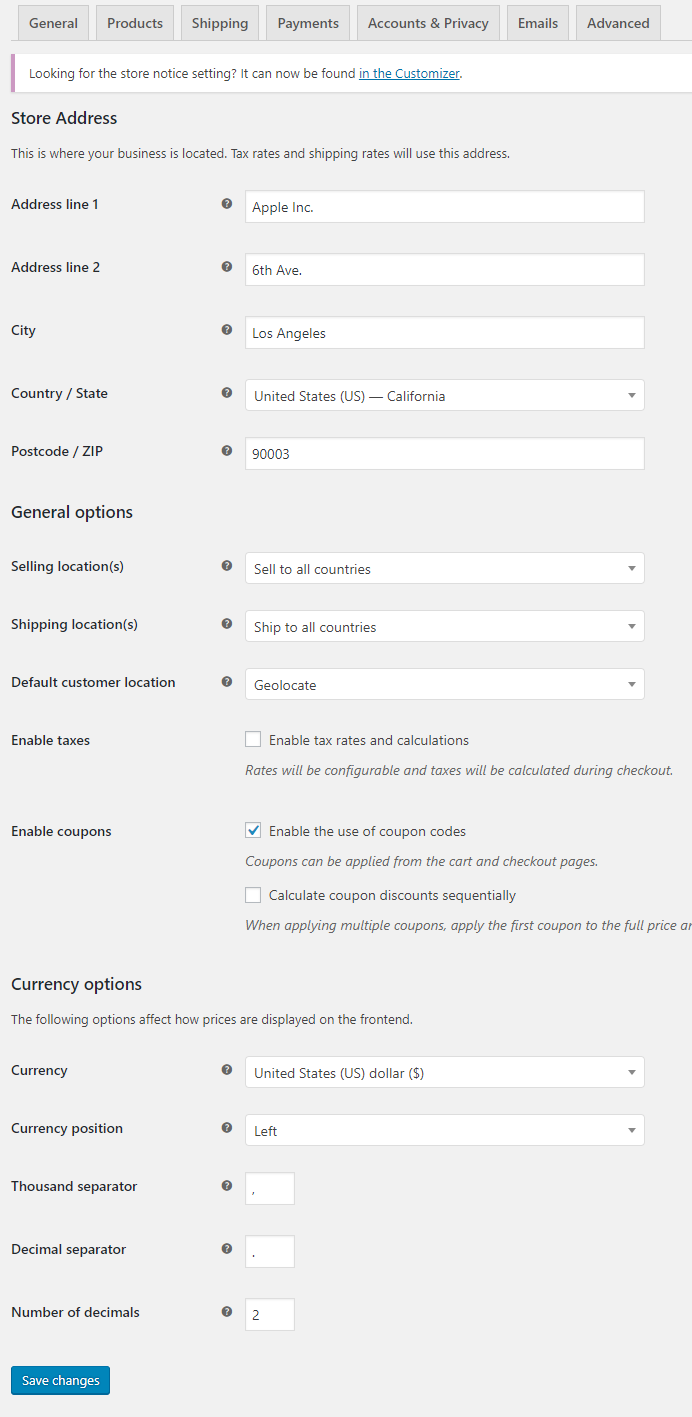
There are various general settings associated with shipping, which you can configure here. They include:
Base Location
Select the location from where you are shipping your orders. In the example above, we have selected the United States (US) – Indiana.
Selling Location
Select the locations to which you wish to sell your products. You can select any one of the options given below from the drop-down:
- Sell to All Countries
- Sell to All Countries, Except For
- Sell to Specific Countries
Shipping Location
Select the locations to which you wish to ship your products. You can select any one of the following options from the drop-down:
- Ship to all countries you sell to
- Ship to all countries
- Ship to specific countries only
- Disable shipping and shipping calculations
Default Customer Location
This is the customer location that you set as default on your online store. This will enable you to determine tax and shipping costs before the customer enters the address information. Besides, there are the following options as well in the drop-down menu that you can choose as the default customer location:
- No location by default: Here, the store owner does not set any default location, and hence no taxes are calculated.
- Shop base address: In this option, you can set the base location of your store as the default customer location.
- Geolocate: Selecting this option enables you to determine the customer’s default location based on the IP address through which the customer logs in.
- Geolocate (with the page caching support): As in the previous option, here also, you can determine the customer’s default location based on the IP address through which the customer logs in. The only difference is that you have to select this option only if your store has page caching support.
After configuring the settings mentioned, you can Save Changes. Thereafter, you need to move to WooCommerce > Settings > Shipping, as shown below in the image.
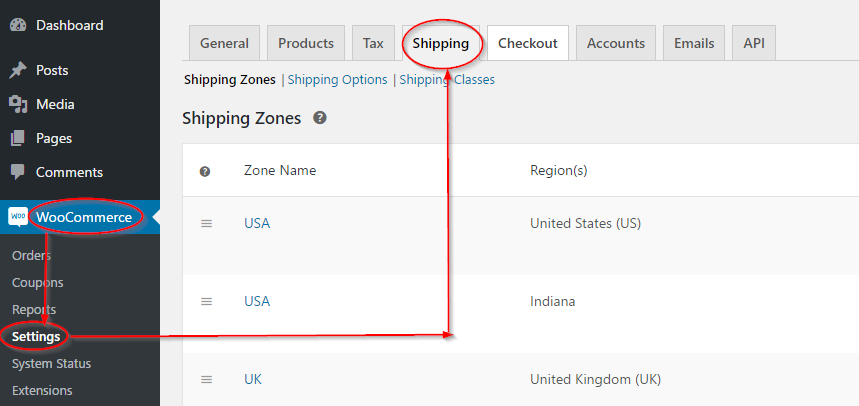
There are three sections under the Shipping tab namely Shipping Zones, Shipping Options, and ShippingClasses.
WooCommerce Shipping Zones
WooCommerce Shipping Zones can be selected based on where you want your products to be shipped. There are various steps in this process that include the following:
WooCommerce Shipping Zone Name
The shipping zone(s) can be selected based on where the store owner wants his/her products to be shipped. Multiple zones can be added based on the location. Naming the shipping zone(s) can be done based on the store owner’s preference.
Region(s)
After selecting the zone, you can select the regions within that zone where you wish your products to be shipped. For example, for the zone USA, you can select particular states or postcodes in the USA where you want your products shipped. Alternatively, you can select the United States for shipping your products across the USA. After selecting the WooCommerce Shipping Zones and shipping regions of your choice, click on Save Changes. This will enable you to select the shipping methods which are applicable to that particular zone and region.
Add shipping method
Once you have added a Shipping Zone, you can select the Shipping method(s) which are relevant to that shipping zone.
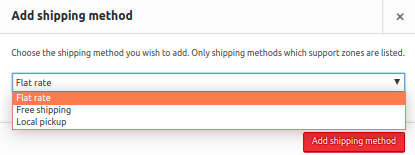
From the drop-down, you can choose any of these three shipping methods listed below:
- Flat Rate
- Free Shipping
- Local Pickup
The shipping methods you select from a shipping zone will be applicable only to customers’ addresses within that particular shipping zone.
WooCommerce Shipping Options
Located in the sub-menu of Shipping, Shipping Options enables the user to configure the availability of the shipping calculator on the cart page or only when an address is entered in the Ship-To field in the store. The user is also able to configure the default Shipping Destination.
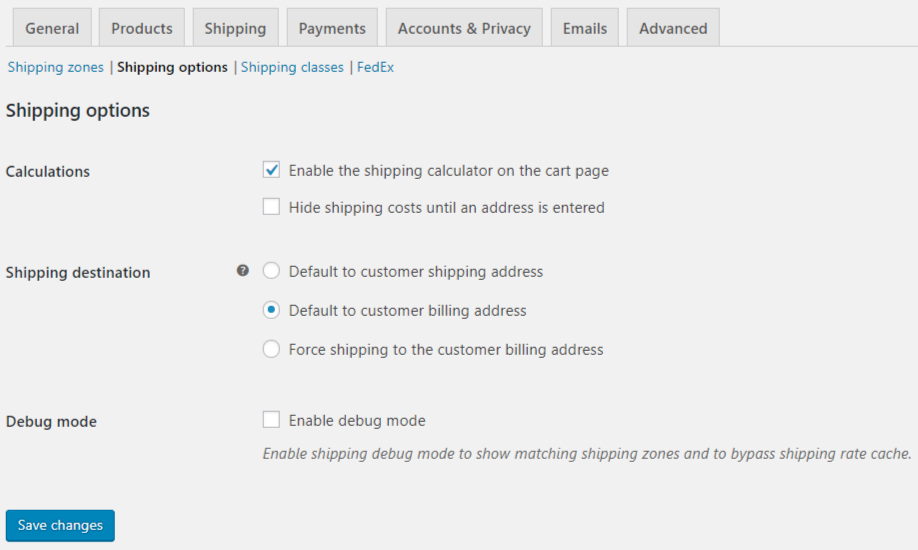
1. Shipping Calculations This section allows you to enable or disable the checkbox for shipping rate calculations. Accordingly, the manner in which the shipping rate calculations are displayed will vary. There are two options in this section: Enable the shipping calculator on the cart page In this option, the customer is able to view the shipping rate calculation on the cart page for each individual item he/she adds to the cart or for all the items added to the cart Hide shipping costs until an address is entered
In this option, the customer is able to view the shipping rate of his/her order only after he/she enters his address while checking out.
2. Shipping Destination This section allows you to choose the customer’s address to which the order will be delivered. The options available in this section are: Default to the customer shipping address In this option, WooCommerce selects the customer’s shipping address by default. This by default will be the address the customer enters while registering to the site. Alternatively, if he/she has not registered to the site, WooCommerce will ask for the shipping address while he/she is checking out. By setting this option, the Checkout page looks like the below:

Default to the customer billing address In this option, WooCommerce selects the customer’s default billing address. This is the address he enters while registering to the site. However, he has the option to change it to another address of his preference. By selecting this option, the Checkout page looks like the below:

Force shipping to the customer billing addressIn this case, only the customer’s billing address is asked for, and this is, by default, taken as the customer’s shipping address, with no option to change it.3. Debug Mode Enabling this option will allow you to debug any shipping-related issue that may arise because of the shipping zone mismatch.
WooCommerce Flat Rate
In this section, WooCommerce allows store owners to set a Flat Rate for shipping. This a fixed rate that is charged based on various parameters like:
- Type of product
- Destination shipping location
- Weight of the product
- Dimensions of the product
- Based on whether it is a special product (bulky, breakable, perishable, corrosive, antique, etc)
A screenshot of the settings for Flat Rate are as shown below:

To access the Flat Rate settings page; click on the link Flat Rate that has been set in Shipping Zones under Shipping Method. Here, the Flat Rate can be set for each zone that was chosen. There are various text boxes in this page like:
Method Title
The method title will, by default, appear as Flat Rate otherwise, enter Flat Rate in the corresponding box. This will reflect in the Cart/Checkout page of the store under Shipping Options.
Tax Status
Here, select whether the Flat Rate for shipping that was chosen is taxable or not. There are two options here:
- Taxable: This option specifies that the flat rate shipping for that particular zone is taxable. Taxes include Sales tax, Value Added Taxes, etc. which can be set in the Tax tab under WooCommerce > Settings
- None: This option specifies that the Shipping costs will not include taxes.
Cost
In this case, you need to enter the cost that needs to be set for the normal products going to be shipped to a particular shipping zone, excluding taxes. Alternatively, enter the sum of the costs for different items together. There are three placeholders that can be alternately entered here:
- [qty] for the number of items
- [cost] for the total cost of items
- [fee percent = “10” min_fee = “20” max_fee = “”] for percentage-based fees
WooCommerce Shipping Class Costs
These costs can optionally be added based on the costs you wish to specify for the different product shipping classes you have created. This section will appear only if you have configured different product shipping classes in the store. Here, store owners have the provision to set specific shipping costs based on the WooCommerce Shipping Classes they have added. The shipping costs set for the shipping classes will be added to the flat rate which would have already been defined.
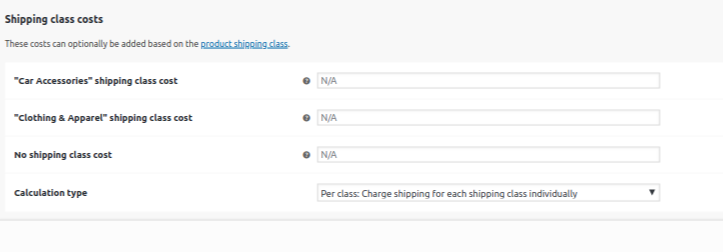
When the shipping rate is calculated for each of these classes, the flat rate will be added to the shipping class cost of each shipping class to arrive at the actual shipping rate. If the product being shipped belongs to a class that has not been defined, then you can set a shipping rate that has not been entered under any shipping class. This cost is set in the No Shipping Class Cost. Setting shipping class costs can be done based on the preference of the store owner.
Calculation Type
In this option of setting the shipping class cost, there is a dropbox where you can decide how you want the shipping cost calculated. The screenshot of this is given below:

There are two options here:
- Per Class: Charge shipping for each shipping class individually: In this option, the shipping cost will be calculated individually for each shipping class and its cost. The total shipping cost will be the sum of each individual shipping class cost according to the items in the order.
- Per Order: Charge shipping for the most expensive shipping class: In this option, the most expensive shipping class will be used for calculating the shipping costs.
WooCommerce Free Shipping
WooCommerce Free Shipping is a special shipping method that can be triggered by coupons and minimum spending. It can generally be offered if the order is being shipped to a destination that is close to the store or a local pickup center. You will be taken to the Free Shipping settings page when you click on the link Free Shipping that you have set in Shipping Zones under Shipping Method. The settings for this are as below:

There are two fields in this section:
Title
This will by default appear as Free Shipping. Otherwise, enter the title Free Shipping. This will reflect in the Cart/Checkout page of the store under Shipping Options.
Free Shipping Requires
You need to enter the criteria or conditions for availing of free shipping from the drop-down menu. The different options in this field are:
- N/A: This option denotes that there is no condition or criteria required for Free shipping
- A valid free shipping coupon: In this option, customers have to provide a free shipping coupon to avail of the free shipping service. Free shipping coupons are generally provided by WooCommerce store owners as part of a marketing strategy.
- A minimum order amount: In this option, the order should meet the criteria of a minimum order amount for the customer to avail of free shipping.
- A minimum order amount OR a coupon: In this option, the customer has to meet the criteria of either a minimum order amount or a free coupon to avail of free shipping.
- A minimum order amount AND a coupon: In this option, the customer has to meet the criteria of both a minimum order amount as well as a free coupon.
Minimum Order Amount
If any of the latter three options are selected, an extra field appears which requires the store owner to enter a minimum amount for which a customer can avail of free shipping. Thereafter click on the Save Changes option to save the settings and changes made.
WooCommerce Local Pickup
With the WooCommerce Local Pickup shipping method, customers have the option to come and pick up their order directly from the local pickup store. By default, when using this method, local base store pickup prices will apply, regardless of the customer’s address. Alternatively, you can provide local pickup for free of cost. You will be taken to the Local Pickup settings page when you click on the link Local Pickup that you have set in Shipping Zones under Shipping Method. The settings for this method are given below:

There are three fields in this section:
- Title: This will by default appear as Local Pickup. Otherwise, you can enter the title Local Pickup. This will reflect in the Cart/Checkout page of your store under Shipping Options.
- Tax Status: If the store owner wants to apply a tax rate for local pickup, he can set it up here. There are two options here:
- Taxable: Here store base tax rates will apply regardless of the customer’s shipping address
- None: This option can be selected if the store owner wishes to waive taxes on local pickup or local pickup charges altogether
- Cost: This is an optional cost that the store owner can set for local pickup
You can now click on Save Changes to save the settings made.
WooCommerce Shipping Classes
A WooCommerce Shipping Class is a group of similar products to which you can add a separate shipping cost. In the same way, you can create multiple shipping classes and add shipping costs for each shipping class. Any change you make in the shipping cost of that class will reflect on the shipping rate of all products in that class. Shipping rate methods such as Flat RateShipping and Table Rate Shipping will enable you to set shipping costs for products in a particular shipping class.
Creating WooCommerce Shipping Classes
Here, you will be taken through a step-by-step process of creating Shipping Classes and adding shipping costs to these shipping classes. To navigate to Shipping Class, follow the steps given below: WooCommerce > Settings > Shipping > Shipping Classes The settings for this is given below:


1. Click on the tab Add Shipping Class to add a new Shipping Class. 2. Add the Shipping Class name under the Shipping Class column. 3. Add a Slug, which can be the shipping class name itself or something similar. 4. Under Description enter something about the nature of the Shipping Class. 5. The Product Count denotes the number of products under a particular shipping class.
Assign WooCommerce Shipping Classes to Products
Add a shipping class to a product while adding it or editing it. To add Shipping Class to a Product, follow the procedure given below: Consider the case where products are already added.
- Choose the Product that needs to be assigned to the appropriate Shipping Class.
- Access the Product Data section
- Click on the Shipping tab on the left
- Select the Shipping Class from the Shipping Class drop-down
- Click on Update
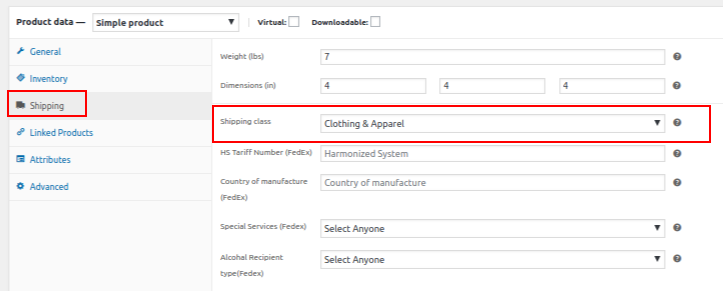
Setting the WooCommerce Flat Rate Shipping method for a Simple product belonging to a Particular Class
The Flat Rate settings can be accessed by navigating to WooCommerce > Settings > Shipping > Shipping Zones > Edit Zone > Add a Shipping Method

Assign rates to particular Shipping Classes as shown below.
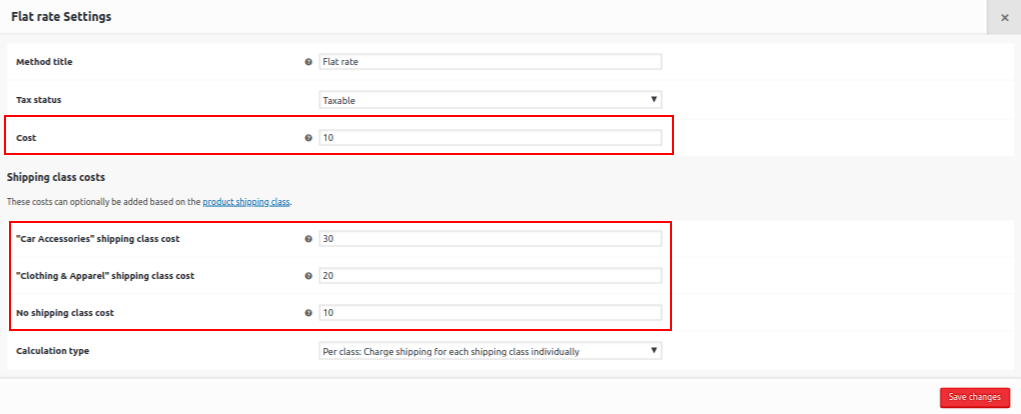
Upon adding products from different WooCommerce Shipping Classes to the cart, the flat rate for the USA that is calculated is solely calculated for the classes which are present in the cart. The flat rate changes when products from different WooCommerce Shipping Classes are added to the cart. This happens in the case where there are different rates for each WooCommerce Shipping Class.
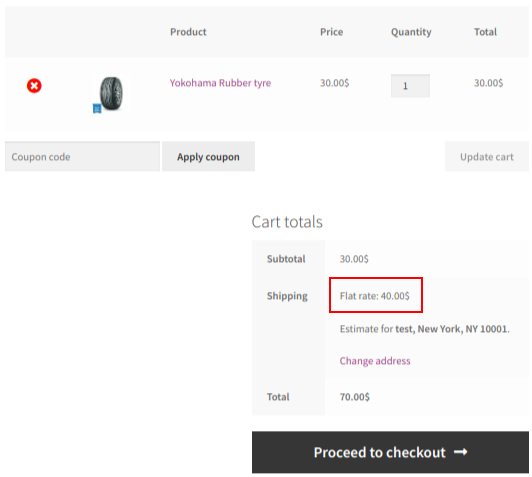
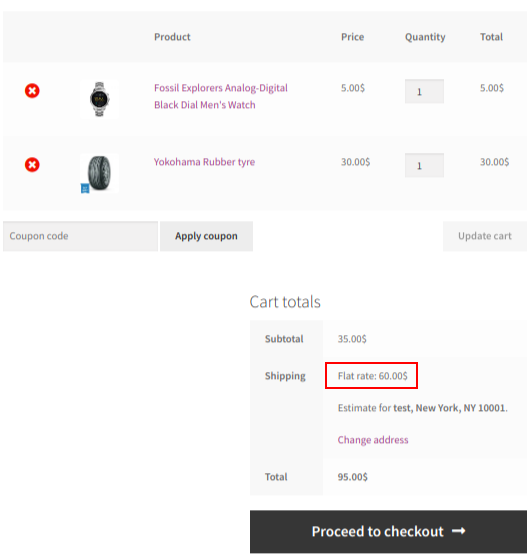
For those products that do not have any WooCommerce Shipping Class assigned to them and if a rate has been set for No Shipping Class Cost then the rates will appear as shown below
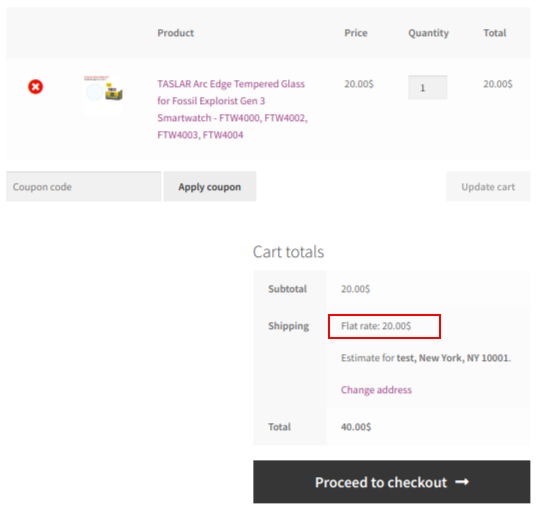
The Flat Rate settings for a simple product belonging to No Shipping Class is given below:

Setting WooCommerce Flat Rate Shipping method for a Variable product belonging to the Parent product
- Assign the Shipping Class to the Parent product.
- Assign the same Shipping Class to the Variable Product by following the below-mentioned steps:
- Access the Product Data tab by scrolling down on the Product page.
- Now select Variations from the left panel.
- Choose the variation the Shipping Class needs to be added to.
- Set the Shipping Class > Same as Parent
- Update the product (Save Changes)
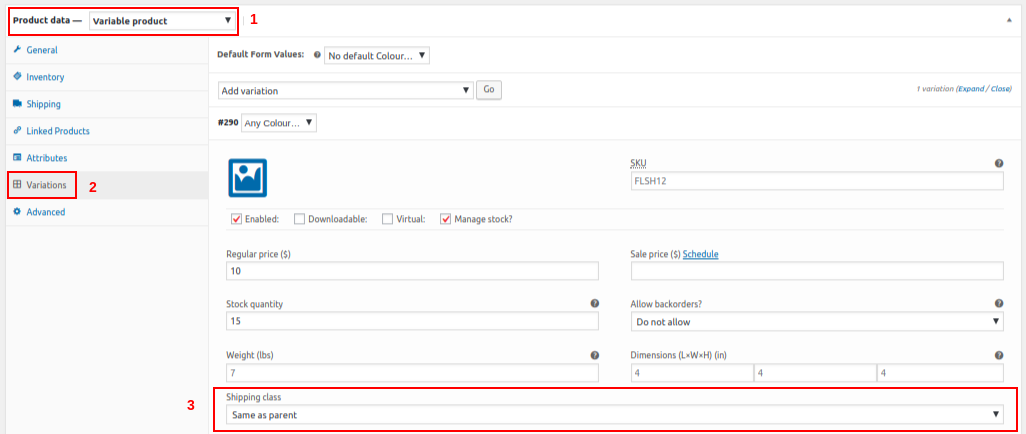
The Flat Rate Settings are as shown below:
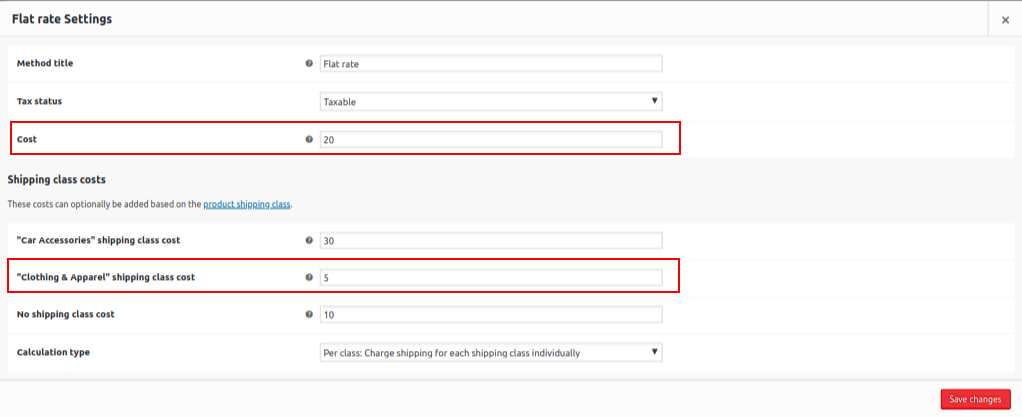
When a variable product is added to the cart the Shipping Class Cost which will be taken into consideration is the Parent Shipping Class of that product (shown below)
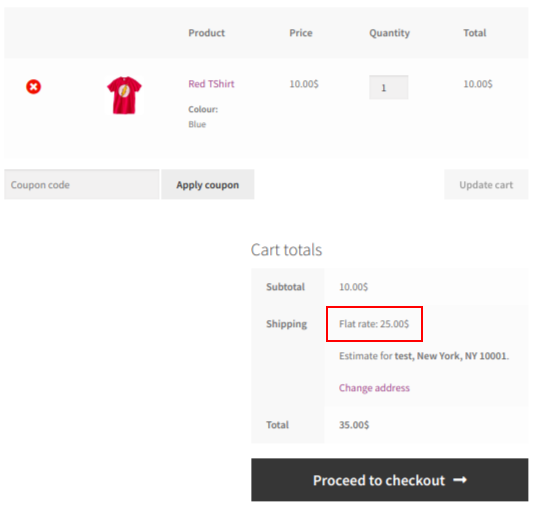
Common WooCommerce Shipping Requirements and Cases
Am I charging my customers too much or too less for shipping? Should I offer Free Shipping? Would I still make a profit if I provide Free Shipping? These are some of the typical questions most WooCommerce store owners ask themselves while formulating their shipping strategy. Getting your product into the hands of your customer in a way that delivers a truly exceptional customer experience, while keeping you profitable, is very important to business success. Here, we will try to list the most popular shipping scenarios and guide you on how you can set this up in WooCommerce.
Offer WooCommerce Free Shipping based on Count, Cost, Destination, and Class
To remain competitive in today’s marketplace, you may be forced to offer WooCommerce Free shipping. Free Shipping has a very positive effect on conversion rates, is easy to explain to customers, and also aligns with customer expectations. It can be a good selling tactic to offer Free Shipping but you should keep in mind that, it may be free to your customers but not to you. Understanding this, some businesses offer Free Shipping, but they slightly increase the prices to cover the shipping cost. But if you choose to offer free shipping in its true sense, it is very important to understand its impact on your business’s bottom line. You will still need to pay the carrier and make sure you’re making enough on each order to cover the associated shipping costs. The most effective approach to Free Shipping is to only offer it for orders where you know you’re making enough on the sale to cover shipping and still make a profit. You could try offering Free Shipping with a minimum order amount or a minimum number of items that makes sense for your business and, maybe try excluding products that are too heavy or bulky for you to offer Free Shipping. A common rationale for offering Free Shipping is that it will help boost sales, leading to more orders and more profits. Free Shipping can also lead to larger orders, particularly when minimum thresholds are applicable. This should drive up your average order value and help you have more margin to apply the shipping cost against. Free Shipping based on order amount or country can be set up using the standard WooCommerce shipping method, Free Shipping. But if you need to offer Free Shipping to specific products, based on a number of products in the cart, etc., you may need to use plugins that allow more complex shipping rules. A very commonly used plugin is the WooCommerce Table Rate Shipping plugin. Examples of Free Shipping cases are:
- Free shipping on all items.
- Free shipping on selected items for orders of $100 or more.
- Free shipping on more than 10 items.
- Free shipping within the USA
- Free Shipping on books and Flat rate on other products.
WooCommerce Flat Rate Shipping based on Quantity, Shipping Class, Destination, and Cost
Another option to consider, while deciding on your shipping strategy, is to offer a Flat Rate for every package. Flat rate shipping works best for businesses that sell products that are fairly small and not too heavy or products that are similar. This eCommerce shipping strategy is as popular as Free Shipping, as it keeps things simple for customers and it’s easier to set up on the website. The Flat Rate method of charging for shipping requires you to figure out your average cost of shipping a package. This is anyway a best practice that you should be doing to make sure that you don’t drastically undercharge or overcharge your customers. When you charge a flat rate, you’ll probably be slightly overcharging or undercharging your customers more than the actual shipping cost. This means you’ll lose money on roughly half of your shipments and make money on the other half. But it all evens out in the end. Flat Rate Example Scenarios:
- Flat rate (say $5 ) on all products, regardless of order value
- Free Shipping on some products and a flat rate for others
- Charge $3 to all locations in the United States
- Flat rates for orders up to $100 and Free Shipping above orders of $100
WooCommerce Weight based Shipping
If you have products that vary significantly in weight, it might be a better idea to go for WooCommerce Weight based shipping. For example, if you sell shoes, jackets, and dresses, a size fit all Flat Rate shipping option may not work as there is a large weight (and price difference) is shipping a pair of shoes compared to a light summer dress. Charging different shipping rates based on weight slabs is common in such scenarios. Beyond the defined range, you can define the shipping rate per weight unit. To figure out your shipping costs you need to actually calculate them by measuring their weight, dimensions, and other factors that affect how much it costs to ship them. Round these numbers up to the nearest whole number. Calculated shipping is the most exact method to make sure products are priced correctly. A typical weight-based shipping rate slab may look like this example: – Cart weight 8lbs or fewer costs $5 – Cart weight 9-15lbs costs $8 – Cart weight 16-30lbs costs $15 – Cart weight more than 30lbs costs $20 In some cases, it is not that simple. You may want to add one more parameter along with weight, for eg. regions. If you want shipping prices to be different based on weight and country or region, then you may try Table Rate Shipping.
WooCommerce Shipping by Cart Total and Quantity
A common requirement is to set shipping costs based on the order quantity or order total. For example, you are selling shoes weighing roughly 1 kg, and usually, charge $3 each for shipping. You could offer a shipping discount of say 25% for orders of 3 or more shoes up to a maximum of 6. This means that if someone buys 4 shoes, the total shipping cost would be $9 instead of the original $12. This is an example of setting shipping costs based on the Cart or Order Quantity which is ideal if you sell multiple items with identical weights or prices. You could similarly set shipping cost as a percentage of the total amount in the cart. It is also a common strategy to offer Free Shipping if the cart subtotal is above a certain amount. For example, you can offer Free Shipping for any order value of $100 or above. These kinds of complex shipping rules are not available in standard WooCommerce. You need to install separate WooCommerce add-ons for implementing such rules. With Advanced Shipping extensions for WooCommerce such as Table Rate Shipping plugin, you can set up shipping rates based on a variety of conditions based on the Cart.
WooCommerce Shipping Rates for Product Category or Shipping Class
WooCommerce product shipping classes or product categories can be used as a way of setting shipping costs for a group of products. For example, products in the category Books can have a different shipping rate than those in the category Furniture. Similarly, products associated with the shipping class small may fit into an envelope and those associated with shipping class large may require parcel shipping. You may define different shipping calculation methods for these classes. You may use the WooCommerce Flat Rate shipping method to associate a flat rate to the shipping class small and use the Table Rate Shipping method to set weight and region-based rates for products with shipping class large.
WooCommerce Shipping Rates based on Per Product
The one-size-fits-all solution may not be suitable for all types of products. If your store is selling one-off, heavy or large products that require additional shipping, unlike the rest of your catalog, general pricing, based on weight or order amount may not be practical. For example, a shop owner who is selling antique items may need to take special care and do specialized packaging and want this reflected in the shipping price. In such cases, you may need the option to set up a separate price for each item in your catalog. The WooCommerce system then adds the per-product shipping fees together to provide a total at checkout. Apart from including cost per product, you also have the facility of defining costs per variation of the product.
WooCommerce Local Pickup or In-store Pickup
If you have a physical store, you can let your customers order products online and choose to pick them up at your store to avoid shipping costs. You can still charge customers a handling fee if you wish to. The local Pickup option is available out of the box in WooCommerce and allows you to configure a local store in any destination you wish, from which customers can pick up the products they have ordered. This sets the geographical perimeter for which customers can pick up their orders. However, for some businesses, local pickup requirements could be a bit more complex than just setting the pickup zone and handling fee. Again, there are plugins, such as WooThemes Local Pickup Plus, that could meet most of the complex requirements.
WooCommerce Shipping Rates from Carriers
Charging what you get charged by your shipping courier is another great eCommerce shipping strategy if you prefer to offer the best possible shipping rate to your customer while still covering your shipping costs. There are WooCommerce add-ons that let you get live rates in real-time directly from carriers such as UPS, USPS, FedEx, Australia Post, Canada Post, or DHL. Once a customer gets to the Checkout page and selects where he/she wants the order shipped, the calculator pulls the available services and corresponding real-time shipping quotes from the shipping service provider by calling the right API. Using a real-time calculator can help you win the trust of customers. It shows that you are not inflating your shipping charges. Customers may also choose the best shipping service that matches their budget and delivery speed requirements. With the right plugin installed, the store owner, can also pay postage online and print shipping labels without leaving the WooCommerce admin interface. This could save a lot of time and effort in shipping your package.
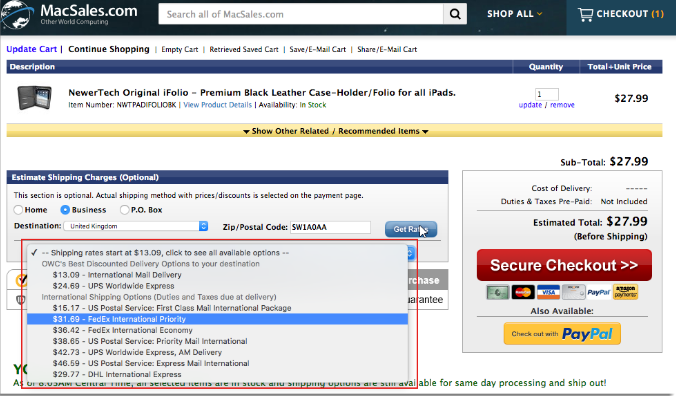
WooCommerce Table Rate Shipping
At times, you will have complex shipping requirements which need a combination of calculation methods. For example, you provide Free Shipping in your home state but charge a Flat Rate for other states in the country. For shipping to international destinations, you charge weight-based shipping rates. You have assigned a shipping class for certain items for which you want to charge a Flat Rate. There could be more requirements in real-life scenarios. If you have complex and advanced shipping calculation requirements, you may rely on the Table Rate Shipping method for WooCommerce. The table Rate Shipping method gives you great flexibility for nearly every scenario. WooCommerce Table Rate Shipping method is arguably the most powerful and flexible shipping method available for WooCommerce. This lets you define rules and set a corresponding shipping rate for a combination of conditions. You can define shipping rates based on the shipping destination, have multiple rates per zone, and add multiple rules based on product weight, cart subtotal, the number of items,shipping class, price and so much more. If the user’s cart matches the rule, the shipping cost you defined for that rule is applied. The basic configuration for the Table Rate Shipping plugin would be as shown below

Rates displayed in the Cart based on Quantity
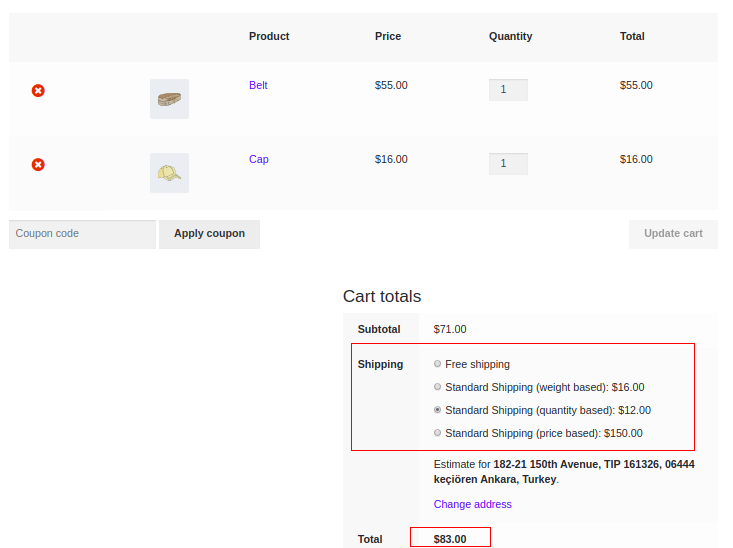
Rates displayed in the Cart based on Weight
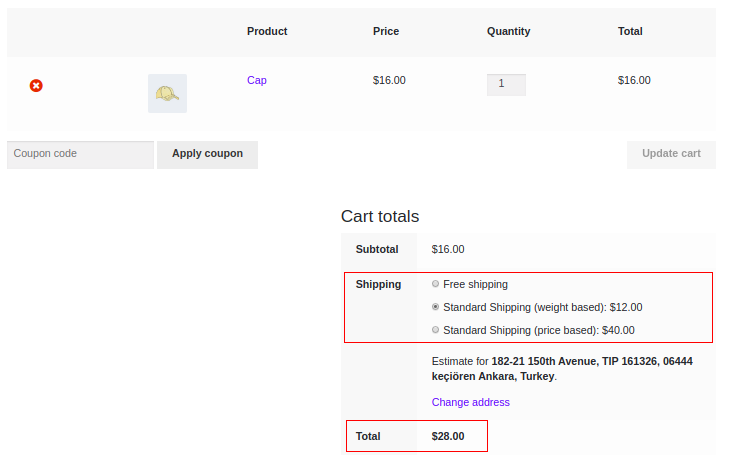
Rates displayed in the Cart based on Price
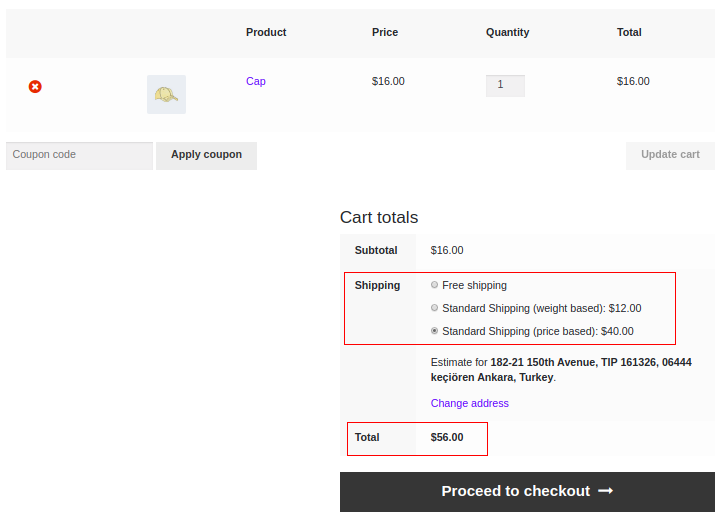
WooCommerce Shipping Rate with Bundle/Combo Offer
Bundle Rate shipping rate is commonly used in shops where customers buy multiple products of similar type. For example, you have set a flat rate for Per Product Shipping but want the Cart to automatically charge the same flat rate per multiples of 5 of the product. So, for instance, if the customer orders 1–5 items, the cost will be $1.00, but if the order is 6–10 products, the shipping will be $2.00, and so on… so it will add an additional shipping fee for every 5 items ordered. This kind of special bundle shipping rate can be configured using Bundle Rate shipping plugins. Another similar requirement is to offer free shipping for one product when purchased along with another.
WooCommerce Shipping Automation
Whether you’re a big or small WooCommerce shop, shipping is a chance to impress or disappoint your customers. Processing orders in a fast and efficient manner are very crucial for an eCommerce business. As you grow, there are a variety of shipping plugins and tools that can further help you streamline your shipping processes. This includes simple plugins which will help you to print invoices, labels, receipts, and packing slips or track orders. You can use plugins that will integrate with many of the most popular courier companies so that you can print more than just shipping labels but the postage as well, which will be directly charged to your account.
Print WooCommerce Shipping Labels and Invoices
It is generally a good practice to include an invoice and packing list when you are shipping a package. It serves as a confirmation of what the package contains along with your contact information and the details of the purchase. It also establishes an extra line of communication between you and the customer and adds a human touch. Furthermore, when you sell internationally, many countries require an invoice to be included. An invoice should contain all the required order details (such as the name and address of your company, the billing address of your customer, and a list of all order items including taxes and totals). If you don’t include one, there is a possibility that their customs officials may assess the value of the items in the package which in some cases is higher than what the customer has paid. This means the customer has to pay higher import fees and you’ll end up having a very frustrated customer.

You may also want to print the address label with or without postage. If you have a business account with a shipping service provider, you can integrate your store with this account and pay the postage and print the label without logging into their online system. This helps to avoid copying and pasting the order and address details.
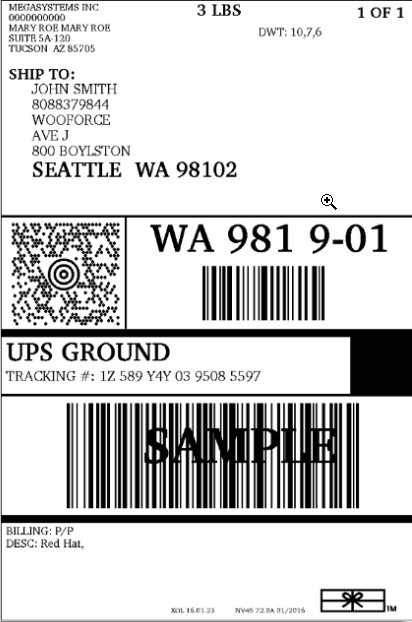
WooCommerce, by default, doesn’t allow you to print the invoice, packing list, or shipping label from your orders page. There are plugins that allow you to do this from your WooCommerce admin area, some of them are:
- WooCommerce UPS Shipping Plugin
- WooCommerce FedEx Shipping Plugin
- WooCommerce Canada Post Shipping Plugin
Set up WooCommerce Shipment Tracking
Once you start shipping your orders, you will also start receiving emails and calls from customers inquiring about the status of their orders. If you can reduce the number of customer emails and calls with these questions, you may save a lot of time and money! With WooCommerce default settings, customers receive an email with order details when they initially place an order, and the order status changes. Your store’s Checkout settings determine which statuses trigger a customer order notification email. You might want to add the order tracking information in one of the emails. There are plugins that will add shipment tracking information to the order completion email. The tracking information gets added to the order details page in the customer account page in your store too. These help customers to trace their order at every stage of the shipment and delivery process without making a call or sending an email to you. Few of these plugins that provide real-time tracking are:
- WooCommerce Shipment Tracking
- WooCommerce UPS Shipping
- WooCommerce FedEx Shipping
- WooCommerce Canada Post Shipping
- WooCommerce Royal Mail Shipping
Export Orders via Third-Party Fulfilment
Not handling order fulfillment yourself? You might either want to integrate WooCommerce into your fulfillment service provider or you will manually export your orders and send them to them. If you are using StorePep, ShipStation, ShippingEasy, ShipWire, etc., there are free plugins available. If you are using a different fulfillment service, you might find an integration plugin in the WordPress repository or somewhere on the Internet. If you are not lucky enough, try talking to a developer. There are Order/Customer Import Export plugins available for WooCommerce that lets you export or import individual orders or bulk orders. This will be useful if you’re using an external shipping system or other third-party software. You can also set automatic export via FTP, HTTP POST, or email for any or all orders.
Conclusion
We hope this guide would have helped you set up WooCommerce shipping on your WooCommerce-based online store. The WooCommerce Shipping plugins mentioned in this guide help users to achieve their shipping goals and includes features that help make the whole shipping process a lot simpler. If you’re new to WooCommerce and don’t know the actual cost of setting up a WordPress/WooCommerce store, then check out How much does WooCommerce cost. You can contact our customer support if you need any help or have any doubts about the plugin. The team will help you through and out so you don’t have to worry.
Happy selling!

